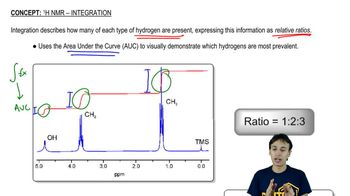Here are the essential concepts you must grasp in order to answer the question correctly.
1H NMR Spectroscopy
1H NMR (Proton Nuclear Magnetic Resonance) spectroscopy is a powerful analytical technique used to determine the structure of organic compounds. It provides information about the number of hydrogen atoms in different environments within a molecule, allowing chemists to infer connectivity and functional groups. The resulting spectrum displays peaks corresponding to different hydrogen environments, with their positions (chemical shifts) indicating the electronic environment around the protons.
Recommended video:
Chemical Shift
Chemical shift refers to the position of a signal in an NMR spectrum, measured in parts per million (ppm). It reflects the electronic environment surrounding the hydrogen atoms; for example, protons near electronegative atoms (like oxygen or nitrogen) typically resonate at lower fields (higher ppm). Understanding chemical shifts is crucial for interpreting the spectrum, as they help identify functional groups and the overall structure of the compound.
Recommended video:
Integration and Multiplicity
Integration in 1H NMR refers to the area under each peak, which correlates to the number of protons contributing to that signal. Multiplicity indicates the splitting pattern of the peaks, which arises from neighboring hydrogen atoms (n+1 rule). Together, integration and multiplicity provide insights into the number of hydrogen atoms in a particular environment and their connectivity, aiding in the elucidation of the compound's structure.
Recommended video:
 Verified step by step guidance
Verified step by step guidance Verified video answer for a similar problem:
Verified video answer for a similar problem:



 12:21m
12:21m